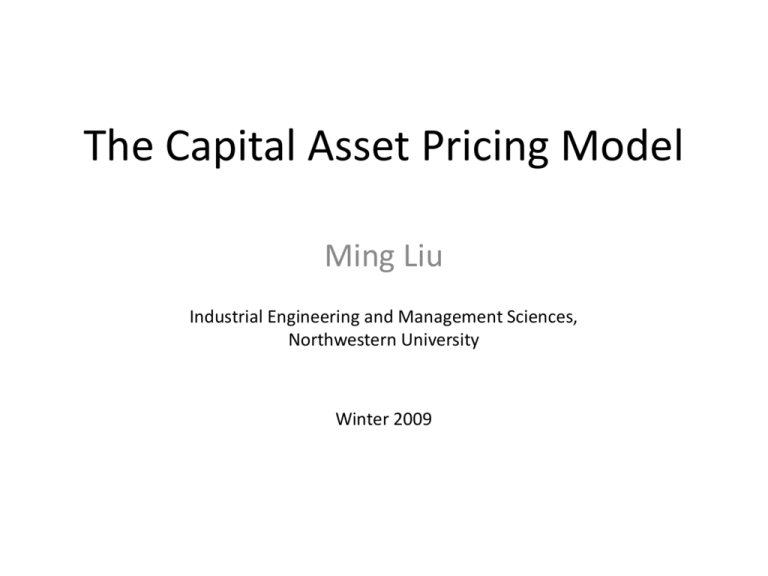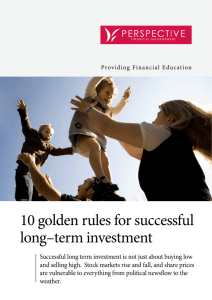The CAPM - Northwestern University
advertisement

The Capital Asset Pricing Model Ming Liu Industrial Engineering and Management Sciences, Northwestern University Winter 2009 Returns to financial securities P0: security price at time 0 P1: security price at time 1 DIV1: dividend at time 1 r = total return = dividend yield + capital gain rate r = DIV1/P0+(P1-P0)/P0 (random variable) ri : the return on security i, Decompose this return ri into that part correlated with the market and that part uncorrelated with the market rm = the return on the market portfolio εi = the specific return of firm i Systemic and Idiosyncratic Risk ri=αi+ βi rm + εi systemic risk undiversifiable risk beta risk market risk idiosyncratic risk diversifiable risk non-systematic risk "Beta" (β) an asset market risk parameter, represents straight-line inclination degree. E is average "residual" yield, describing an average asset yield deviation from "fair" yield as shown by the central line. ri=αi+βi rm +εi The larger is βi , the more subject to market risk is this firm. The larger is σ[i] the more important is firmspecific risk. [ri ] [rm ] ( [ i ]) 2 i 2 2 Example Decomposing the Total Risk of a Stock Considering two stocks: 2 A: An automobile stock with βA=1.5, [ A ] .10 2 B: An oil exploration company with βB=0.5, [ B ] .18 The variance of the market return is [rm ]2 .04 What is the total risk of each stock? [rA ]2 1.52 0.04 0.10 0.19 [rB ]2 0.52 0.04 0.18 0.19 Which has a higher expected rate of return? Portfolio risk 1. Decompose each security return into systematic and idiosyncratic risk: ri=αi+βirm+εi 2. Form a portfolio of these securities, with portfolio weights w1, w2, …, wn . (sum to one) 3. The portfolio rate of return is a weighted average of the individual returns rp = w1r1+w2r2+…+wnrn rp = w1[α1+β1rm+ε1] + w2[α2+β2rm+ε2] + … + wn[αn+βnrm+εn] Rearrange to get zero rp = α*+β*rm+ε*, where α*:= w1α1+w2 α 2+…+wn α n β*:= w1 β1+w2 β2+…+wn β n ε*:= w1 ε1+w2 ε2+…+wn εn Conclusions • β of portfolio is weighted-average β • Well diversified -> risk only from βrm term The standard deviation of a well diversified portfolio: [rp ] * [rm ] Construct the market portfolio • The market portfolio includes every security in the market • The weight of each security in the portfolio is proportional to its relative size in the economy • A common proxy measure for the market portfolio is the S&P 500 index. http://www.indexarb.com/indexComponentWtsSP5 00.html The Capital Asset Pricing Model Market model ri=αi+βirm+εi with αi=(1-βi) rf ri=(1-βi) rf+βirm+εi ri=(1-βi) rf+βirm+εi • Does this restricted case make sense? What does it imply for the return on a risk-free asset (βi=0)? What does it imply about the return on an asset that has the same market risk as the market portfolio (βi=1)? • The CAPM equation can be rewritten as ri-rf=βi (rm –rf )+εi The CAPM can also be written as a linear relationship between the β of a security and its expected rate of return, E(ri )-rf=βi (E (rm )–rf ) E(ri ) : expected rate of return on the security E (rm): expected rate of return on the market portfolio rf : the risk free rate βi : the security’s beta The Security Market Line E(ri ) E(ri )=rf+βi (E (rm )–rf ) E(ri )=(1- βi)rf+βi E (rm ) E(rA ) E(rB ) rf βB=0.5 βA=1.5 βi Example Using the Security Market Line (SML) The β of Cisco Systems is about 1.37. The risk free rate rf=0.07 Expected risk premium on market E (rm )–rf =0.06 The expected rate of return on CSCO: E (ri ) 0.07 1.37 0.06 0.1522 How to get β? • If we know σ[ri] ----- standard deviation of ri σ[rm] ----- standard deviation of rm ρim----- correlation between ri and rm cov( ri , rm ) im [ri ] [rm ] im [ri ] i 2 2 [rm ] [rm ] [rm ] How to get β? • ˆ imˆ [ri ] ˆ Estimate beta: i ˆ [rm ] ri=αi+ βi rm + εi • http://finance.yahoo.com/ • CAPM serves as a benchmark – Against which actual returns are compared – Against which other asset pricing models are compared • Advantages: – Simplicity – Works well on average • Disadvantages: – What is the true market portfolio and risk free rate? – How do you estimate beta? – Standard deviation not a good measure of risk.








